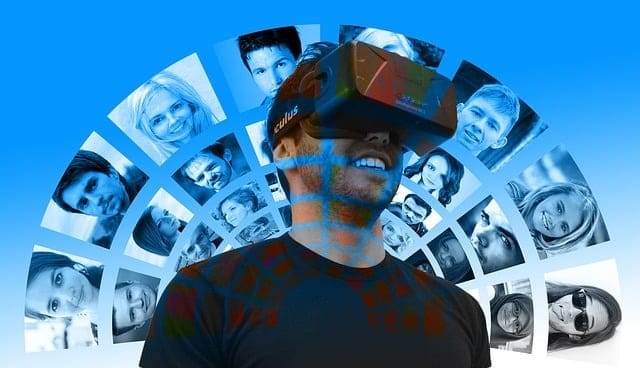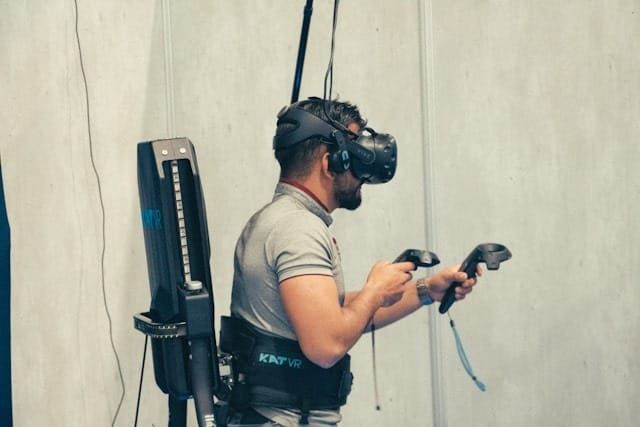Benefits of Virtual Reality: How VR Is Redefining Experiences Across Industries
The way you experience the world is changing, thanks to Virtual Reality (VR). Once limited to gaming and entertainment, VR has become a powerful tool, transforming industries from healthcare to education and business. VR is redefining how you work, learn, shop, and connect through highly immersive experiences that blend the physical and digital worlds.
In this blog, we will discuss the key benefits of Virtual Reality, explore its business applications, and understand how VR enhances your personal and professional experiences across industries.
Key Benefits of Virtual Reality
Virtual Reality has evolved from entertainment to essential enterprise technology. Here are the most significant benefits of Virtual Reality that you need to know in 2026:
1. Realistic and Immersive Learning Experiences
You can now learn complex skills in safe, simulated environments that replicate real-world scenarios. From surgery to industrial safety training, VR provides immersive experiences that improve knowledge retention and confidence. According to the U.S. Department of Education, experiential learning, such as VR, can increase engagement and retention rates by over 70% compared to traditional methods.
2. Cost-Effective Training and Development
VR eliminates the need for expensive physical setups or travel. Whether you're training employees or onboarding new hires, VR modules can be scaled globally at a fraction of the cost. A PwC study found that VR learners train up to four times faster and feel 275% more confident applying their skills afterwards.
3. Enhanced Customer Engagement and Retention
In marketing and retail, Virtual Reality experiences allow your customers to interact with products before buying. They can visualize furniture in their home or try on clothing virtually. These immersive previews increase purchase confidence and brand loyalty, making VR for business a key driver of modern customer experience strategies.
4. Improved Collaboration and Productivity
Remote teams can collaborate in shared 3D environments instead of flat video calls. VR enables real-time co-creation, design reviews, and brainstorming sessions, creating a sense of presence that enhances communication and innovation. VR collaboration can reduce project turnaround times and improve productivity.
5. Faster Design Prototyping and Visualization
Architects, engineers, and product designers can visualize projects in 3D before production begins. This allows you to spot design flaws early and make informed decisions quickly. The ability to walk through a virtual model accelerates innovation and reduces costly revisions, a significant benefit of Virtual Reality for engineering and manufacturing sectors.
6. Accessibility and Inclusion in Learning and Work
VR opens new possibilities for people with disabilities or limited mobility. You can explore virtual environments, attend digital classrooms, or engage in professional training without physical constraints. This accessibility aspect aligns with the Americans with Disabilities Act (ADA) goals, ensuring inclusive opportunities for all
Business Applications of Virtual Reality
The business applications of Virtual Reality are redefining customer engagement, operations, and product innovation. You can use VR to streamline workflows, elevate brand experiences, and improve decision-making in nearly every industry. Here's how VR is transforming business across key sectors:

Retail: Virtual Product Demos and Immersive Shopping Experiences
Imagine allowing your customers to walk through a digital store, try on clothes, or see how furniture fits in their homes without even leaving their couch. That's what Virtual Reality experiences bring to retail. You can deliver immersive experiences that help customers visualize products before purchase, significantly increasing satisfaction and reducing return rates.
Retail giants like IKEA and Nike already use VR showrooms and customization tools that empower you to personalize products interactively. This hands-on digital engagement has proven to boost sales conversions for the brands.
Real Estate: 3D Tours of Homes, Hotels, or Event Venues
In real estate, VR is revolutionizing how properties are marketed and sold. You can offer potential buyers or tenants 3D virtual tours of homes or commercial spaces, giving them the ability to "walk through" a property from anywhere in the world. This not only saves travel time but also widens your reach to global clients.
Hotels and event venues are adopting similar approaches, offering virtual walkthroughs that help clients visualize setups and amenities before booking. Platforms like Matterport and REinVR make it possible to host interactive property tours in minutes.
Healthcare: Surgical Training and Therapy for Anxiety or PTSD
In healthcare, VR is one of the most promising innovations of the decade. Medical professionals can now practice complex surgeries in safe, simulated environments that mirror real-life conditions. This helps reduce human error and improve procedural outcomes.
Beyond surgery, VR has also proven effective in mental health therapy. You can use Virtual Reality experiences to help patients manage anxiety, phobias, and post-traumatic stress disorder (PTSD).
Automotive: Virtual Test Drives and Design Simulations
In the automotive industry, VR for business is driving innovation in design, engineering, and sales. You can now take customers on virtual test drives of vehicles that haven't even been produced yet. This not only enhances buyer confidence but also helps carmakers gather valuable feedback before manufacturing.
Design teams also leverage VR to visualize internal components and aerodynamics, reducing the time and cost of physical prototyping. Brands like BMW and Ford have already integrated VR into their design process, cutting development cycles.
Entertainment: VR Concerts, Interactive Films, and Sports Viewing
Entertainment is one of the most visible and exciting business applications of Virtual Reality. You can now attend live concerts, explore 360° films, or watch sports games from the front row through VR headsets. This level of immersive experience redefines audience engagement and opens new revenue streams for creators.
Platforms like Meta Horizon Worlds and NextVR are leading the shift toward social VR, where you can interact with others in real time.
Benefits of Virtual Reality Across Industries
The benefits of Virtual Reality extend far beyond entertainment. Technology is transforming how you learn, design, heal, and collaborate. VR is now a cross-industry technology that enhances productivity, engagement, and innovation. Below are examples of how Virtual Reality experiences are driving meaningful change across key sectors.
Education and Training
In education, Virtual Reality is revolutionizing the learning process by making abstract concepts tangible and lessons interactive. You can take learners beyond textbooks into fully immersive environments that promote deeper understanding and retention.
Applications of VR in Education and Training:
Virtual Classrooms: Create lifelike environments where students can interact with lessons, teachers, and peers in real time.
Skill Simulations: Practice science experiments, engineering tasks, or surgical procedures safely before performing them in the real world.
Cultural Immersion: Take virtual field trips to historical landmarks or distant countries for experiential learning.
Advertising
In advertising, Virtual Reality is revolutionizing how brands capture attention and drive engagement. You can use immersive experiences to connect emotionally with audiences, turning passive viewers into active participants.
Applications:
Immersive Brand Campaigns: Allow users to "step inside" a story, exploring a product or environment interactively.
Virtual Product Launches: Create digital events that reach global audiences without geographical barriers.
3D Ad Environments: Design experiential ads that boost recall and brand affinity through interaction and storytelling.
Manufacturing and Engineering

In manufacturing and engineering, VR for business accelerates innovation by enabling you to design, test, and refine products in a fully virtual space. This not only reduces costs but also minimizes errors before physical production begins.
Applications of VR in Manufacturing and Engineering:
3D Prototyping: Visualize product designs in a simulated environment, identifying flaws early in development.
Safety Training: Simulate high-risk scenarios to train workers safely without exposing them to real hazards.
Remote Collaboration: Collaborate on design adjustments with global teams using shared virtual workspaces.
Healthcare and Therapy
VR has emerged as a life-changing technology in healthcare, enhancing both medical training and patient treatment. You can simulate surgeries, educate patients, or support mental health therapy through personalized, immersive experiences.
Applications of VR in Healthcare and Therapy:
Surgical Simulation: Train surgeons and medical students in realistic, risk-free environments.
Therapeutic Treatment: Use VR exposure therapy for PTSD, phobias, anxiety, and pain management.
Patient Education: Help patients visualize procedures or understand their conditions interactively.
Research by the National Institutes of Health (NIH) shows that VR-based therapy can reduce anxiety and pain levels.
Tourism and Hospitality
Virtual Reality is transforming how travelers explore and plan trips. You can offer guests immersive experiences that let them "preview" destinations, hotels, and attractions before booking, enhancing confidence and excitement.
Applications of VR in Tourism and Hospitality:
Virtual Tours: Allow travelers to explore hotels, cruise ships, or landmarks through 360° VR walkthroughs.
Experience Previews: Showcase cultural festivals, safaris, or resort amenities before purchase.
Staff Training: Train hotel staff in customer service, crisis management, or facility operations within simulated scenarios.
Architecture and Real Estate
For architects, builders, and real estate agents, VR has become an essential visualization tool. You can showcase spaces before they're built, helping clients understand designs, layouts, and aesthetics long before construction begins.
Applications of VR in Architecture and Real Estate:
3D Virtual Walkthroughs: Let clients "walk through" properties to experience layouts and lighting in real time.
Design Visualization: Review architectural models collaboratively with clients and stakeholders.
Property Marketing: Use immersive property tours to attract buyers and investors remotely.
Corporate Training and Workforce Development
Corporations across industries are using VR for business to train employees faster, safer, and more effectively. You can simulate real-world job scenarios, measure performance, and improve retention without disrupting operations.
Applications of VR in Corporate Training:
Soft Skills Training: Develop leadership, negotiation, and communication skills through lifelike simulations.
Safety Drills: Recreate hazardous situations in VR to train employees without risk.
Onboarding Programs: Offer new hires virtual company tours and interactive orientation sessions.
Defense and Emergency Response
In defense and public safety, Virtual Reality experiences have become essential for mission readiness and crisis management. You can simulate high-risk environments to train personnel in decision-making, coordination, and rapid response without endangering lives.
Applications of VR in Defense and Emergency Response:
Combat Simulation: Train soldiers in realistic, controlled combat scenarios that mimic battlefield conditions.
Crisis Management: Prepare emergency responders for natural disasters, fires, and rescue missions through lifelike VR drills.
Equipment Familiarization: Let teams practice using new gear or vehicles virtually before deployment.
Flam in Action: Redefining Immersive Advertising
A standout example of innovation in VR advertising is Flam, a platform known for creating interactive, shareable VR experiences without heavy hardware. Brands leveraging Flam have seen higher engagement rates and improved customer retention through interactive storytelling campaigns.
Conclusion
Virtual Reality is redefining how you learn, work, and engage, turning imagination into tangible experience. Its ability to blend realism with innovation makes it a powerful tool for training, design, and customer interaction across industries. The benefits of Virtual Reality now lie in its power to create deeper connections and smarter business outcomes.
Bring your brand to life with Flam, the AI-first product suite built for enterprises to create, publish, and scale immersive, interactive advertising experiences. Transform your campaigns into unforgettable journeys with Flam today.